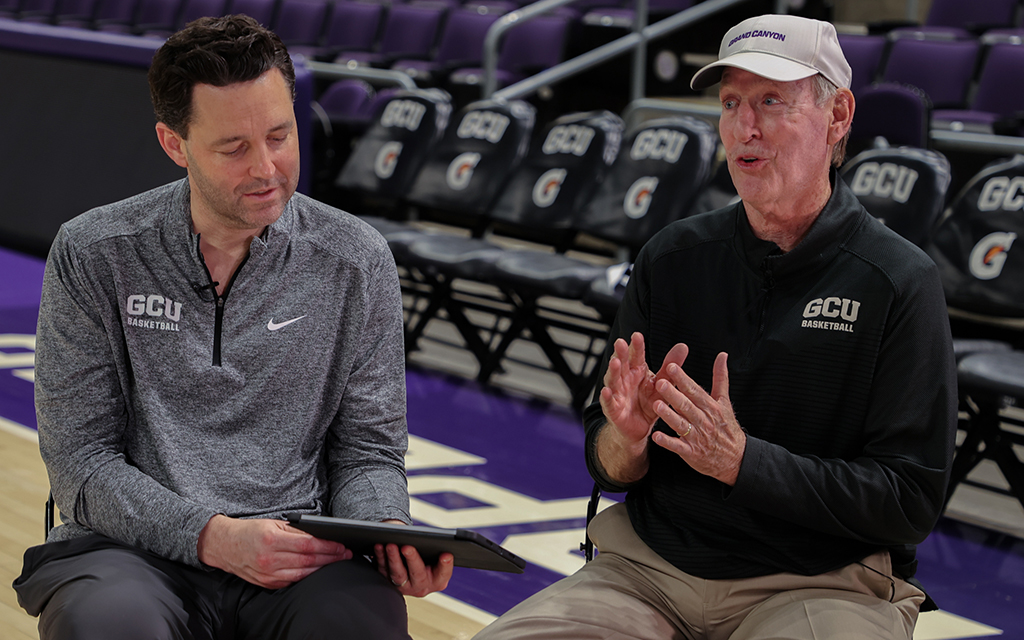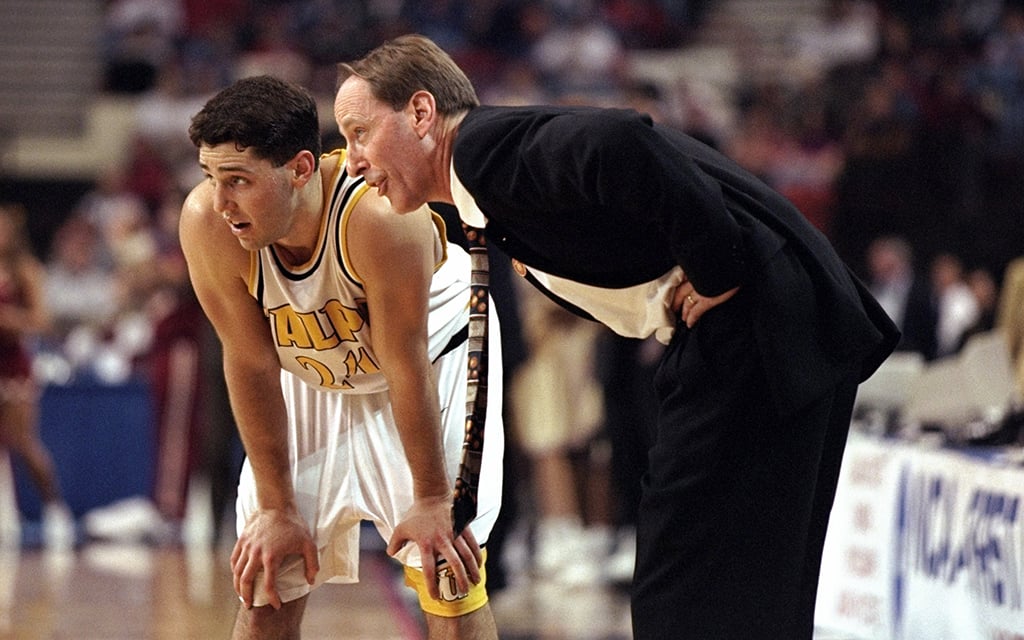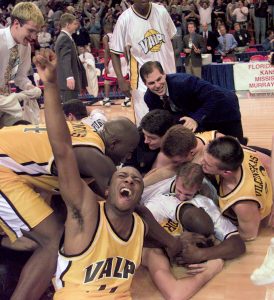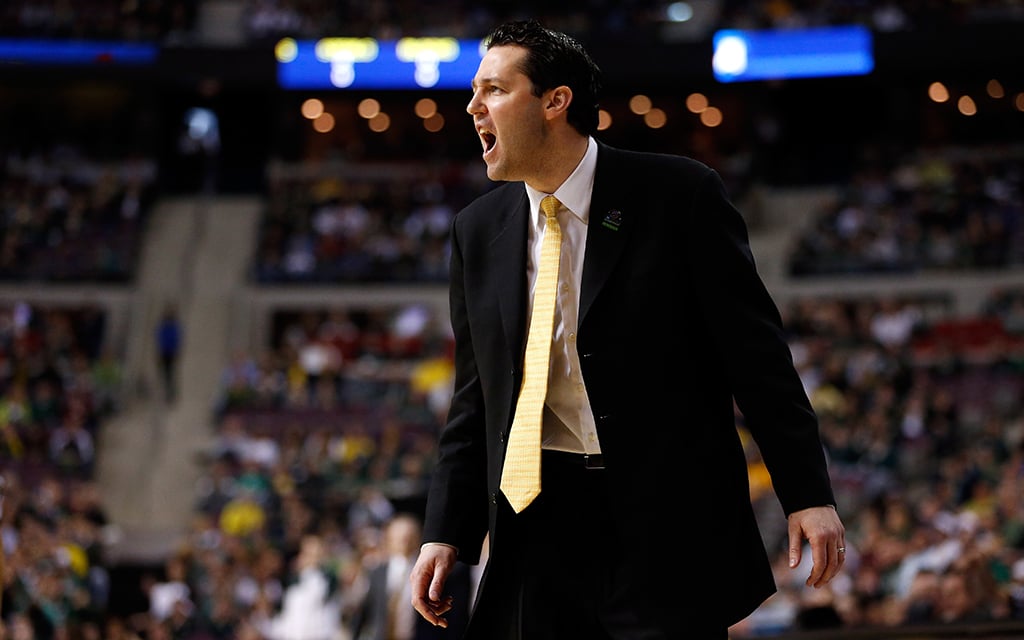
Grand Canyon coach Bryce Drew, left, and his father, Homer, still remember the details of the buzzer beater shot that lifted Valparaiso over Ole Miss. (Photo by Grace Edwards/Cronkite News)
PHOENIX — The moments remembered rarely service the whole of a story. They tend to commemorate a climax at the expense of the details, the epic rise which built it and the euphoric fall that followed. Meaning is often lost, or lessened.
For the last 25 years, “The Shot” has starred in its fair share of NCAA March Madness montages.
Bryce Drew, who sank a 3-pointer at the buzzer, was the hero. Homer Drew, his father, was the coach. Valparaiso, a No. 13 seed, was their team. No. 4 Ole Miss was the opponent. The final was 70-69, Valpo.
But, what else?
The details haven’t escaped Bryce or Homer to this day — where their famous play originated, who inbounded the ball, who received it and what allowed them the opportunity to run it for the win in the first place — perhaps because even their present plot line stretches parallel with the past.
Though far removed from the feeling of taking a low-enrollment Lutheran university to its first Sweet 16 appearance and only one since, Bryce is now the coach of a Grand Canyon program that’s not even a decade-old member of Division I athletics and is approaching its second NCAA Men’s Basketball Tournament in his third season. And the situation seems even more similar since GCU is ranked No. 14 and as much or more of an underdog against No. 3 Gonzaga than Valpo was on March 13, 1998, when he and Homer’s efforts combined with many others to culminate in an improbable memory made plausible.
“What the world needs to know: What we saw on TV probably was the best that we ever executed it,” Homer told Cronkite News. “I mean, we would in practice, we would do 5-on-0 and sometimes a pass never got through or Bryce didn’t make the shot. And then we’d go 5-on-5 , very seldom did we get all the way to the shot.”

Grand Canyon coach Bryce Drew, left, and his father, Homer, still remember the details of the buzzer beater shot that lifted Valparaiso over Ole Miss. (Photo by Grace Edwards/Cronkite News)
It was called “Pacer,” a play Homer said he picked up from former NBA coach Hubie Brown at a clinic he attended many years ago. Suited for game-ending sequences, it generally required three players to touch the ball: Those three for Homer’s 1997-98 team were Jamie Sykes, Bill Jenkins and Bryce, in that order. Sykes was a two-time all-conference baseball player who competed for half a decade in the minor leagues after the Arizona Diamondbacks drafted him in the 11th round in 1997, Jenkins was a high flier who grabbed a team-leading 7.5 rebounds per game standing at 6-feet-6, and Bryce was a 43.3% 3-point shooter.
It seemed simple.
Sykes would throw the ball three-quarters the length of the court, Jenkins would leave his feet to secure possession and Bryce would then receive a tap pass to thrust up a catch-and-shoot 3.
“All I did was put our pieces,” Homer said when first installing the play in practice. “I put Jamie because he was our best passer at that time, Bill was our best jumper and obviously, Bryce was our best shooter.”
The first and only other time Valparaiso ran it that season resulted in a poor look from Homer’s point of view, as he watched Western Illinois walk away with a one-point New Year’s Eve win — one of the team’s three losses in the Mid-Continent Conference. Subtle changes were surreptitiously adopted, though they apparently made all the difference as March rolled around.
By then, Bryce was a back-to-back conference player of the year who warranted the kind of attention Homer planned to use to their advantage. Instead of looking for Jenkins outright, Sykes was to at least give a glance to Bryce while he walked his man down. That way, when Sykes whipped the pass to Jenkins, Bryce could release and create some separation if his defender cared to deny him the inbounds.
Homer was ready with the wrinkle bookmarked. But his players beat him to it, hollering “Pacer! Pacer! Pacer!” with possession and 2.5 seconds to pull off their upset bid.
“I was so in the moment and so focused,” Bryce said. “The play that it happened, it was really a blur.”
One that Rob Evans somehow saw in slow motion.
The former Ole Miss coach, who later coached at Arizona State for eight seasons, insisted that he was not at all surprised, that he couldn’t be after what he said transpired eight years earlier during his days as an Oklahoma State assistant under Eddie Sutton. In what ended as a 30-plus-point conference win for the Cowboys, Evans remembered a play Kansas State ran to conclude the first half with a field goal. The play itself wasn’t necessarily notable, but Sutton’s supposed displeasure with not having seen what was drawn up appear in film study left Evans with a lasting takeaway: He would never again fall short of finding every one of a team’s possible plays, no matter how frequent or infrequent they’re used.

Homer Drew, right, coached his son Bryce at Valparaiso. He said the play involving Bryce’s famous buzzer beater shot in the 1998 NCAA Men’s Basketball Tournament was never executed that well in practice. (Photo by Stephen Dunn/Getty Images)
It was no coincidence that he called up the lone instance in which Valparaiso ran Pacer as part of Ole Miss’ preparation, which was especially exhaustive for a team that had won eight of its previous nine games and placed No. 13 in the final AP poll. Evans didn’t allow any amount of momentum to discount the opponent his team had ahead, and he therefore brought a base understanding of what to emphasize to his backup point guard, Jason Flanigan.
Flanigan, a 6-foot-1 freshman who went on to start in subsequent seasons for the Rebels, was tasked by Evans with face-guarding and forcing Bryce from any involvement in a potential game-winning buzzer beater.
In hindsight, that conversation was a foreshadow to failure.
“I had told him because I knew they were going to Bryce Drew, and I said, ‘Do not leave Bryce Drew,’” Evans said. “He didn’t leave him. But what happened is, when they threw the ball, he followed the flight of the ball. And when he followed the flight of the ball, Bryce, being the smart player that he was, he sneaked out on him and by the time that Jason found him, Bryce already had the ball and had a good look at the basket.”
It’s at this point when the what-ifs worsened the disappointment of a dramatic end to Evans’ six-year tenure in Mississippi, which was technically at its peak. Ole Miss had won its most games since 1937-38 with its second all-time SEC Player of the Year in Ansu Sesay, a 6-foot-9 forward who scored 18.6 points per game while shooting 45.6% from the field, 35% from distance and 72.7% from the free-throw line. Pieces were falling in place for what Evans said could have been a Final Four team, which may have affected an alternate reality in which he doesn’t leave for Arizona State within a month from that Friday.

Bryce, left, and Homer Drew share a hug after a game that was supposed to go Mississippi’s way. Old Miss was seeded fourth and Valparaiso was seeded 13th. (Photo courtesy of Valparaiso Athletics)
If only Sesay’s sharp left-handed shot didn’t shrivel under pressure, as hadn’t often occurred throughout a season in which he made and attempted the second-most free throws in the SEC.
“If he made one, then my decision was going to be not to let them have a chance to get a 3 off because I knew Bryce Drew was a tremendous shooter,” Evans said.
Sesay not only missed both, but the second traveled out of bounds after Keith Carter was tagged with the last touch. The Crusaders, now known as the Beacons after a name change in 2021, had hope.
“I think if it had gone to a replay, which they didn’t have back then, ball might’ve gone to Ole Miss,” said Todd Ickow, who’s been the radio play-by-play voice of Valpo basketball for more than three decades. “It’s hard to tell. It was ruled on the court, Valpo ball. But it was really, really tight.”
Oh, the irony of fate.
“A lot of people don’t even know this, but he had an open look for three in the same score with under seven seconds to go and he rimmed it out,” Ickow said, “and I remember thinking, ‘His career cannot end this way.’”
By contrast, Bryce said he “had a peace about it.” In four years, the 6-foot-2 guard had graced a small Indiana town with four consecutive Mid-Continent Conference championships and three NCAA Tournaments — all firsts for the program — amid a bevy of big shots. One miss didn’t need to be his defining moment.
He could’ve called it there.
Still, he wasn’t going to turn down a second chance at “another miracle,” as Ickow exclaimed in the aftermath of Bryce’s 819th 3-pointer that snuck up and over the front rim, filtered through the net and quelled the qualms of Valparaiso fans in one fell swoop.
“As it was arched up high, it looked like it was going to be short,” Homer said. “I think that all the prayers in the building just lifted it over.”
He had 22 points and added as many more in Valpo’s 83-77 Round of 32 win over No. 12 Florida State that made it the second-ever No. 13 seed to advance to the Sweet 16. Only four other such teams have since done so.

Bryce Drew, buried under his teammates, collapsed to the floor after the winning shot. Valparaiso won one more game in the NCAA Tournament, over Florida State. (Photo courtesy of Valparaiso Athletics)
“People remembered where they were, I mean, kids who were in fourth grade, the teacher stopped and watched the game on TV,” Homer said.
“When we came back to campus, we had to have a police escort because the crowd – we couldn’t even get across campus to the arena because there was so many fans, both students and then the community. When you entered the Valpo area, then they had to lead us all the way in and so it was just really neat to see all your friends and neighbors.”
The run was arguably as monumental for Homer as it was for Bryce. Homer has been retired since 2011, and there may not be another win for him as a coach that careens so close to home. He and his two sons – Bryce and Scott, a former assistant coach and active recruiter in Valpo who’s since won a national championship in his ongoing 20-year tenure at Baylor – grasped the glory of a family achievement that also funneled success to a given school.
As Scott sits with the No. 3 Bears, Bryce’s Lopes appear to be years away from sustaining a caliber that even took Scott the better part of this century to cultivate.
The opportunity Bryce found at GCU, though, was one that revived him from a one-year respite in his coaching career, when he worked as an ESPN analyst after Vanderbilt fired him following its worst season in program history. Put simply, the last thing people recalled as he was hired to head the Lopes was the Commodores’ 0-18 SEC record in 2018-19. Now, those in the Valley know him for winning his second WAC Tournament championship by leading the conference’s No. 5 seed to four wins in five days.

In 11 seasons as a head coach, Bryce Drew has taken five teams to the NCAA Men’s Basketball Tournament. (Photo by Gregory Shamus/Getty Images)
Any chapter, as remarkable as his game-winning buzzer beater or as remissive as the 3-pointer he missed seconds before, is just one of many.
“Over the next 10 years, you can make the argument that Valpo was the best mid-major in the country,” Ickow said. “It was all lifted up from the Drew family, really: Scott’s recruiting and Homer as head coach and Bryce as a player.”
Now, as a coach himself, Bryce Drew seeks to stamp his name into new NCAA Tournament lore. A GCU upset of Gonzaga would do just that. And, who knows.
Maybe another shot or two or more will show up with stories of their own, somewhere along the way in a Lopes survive-and-advance scenario.